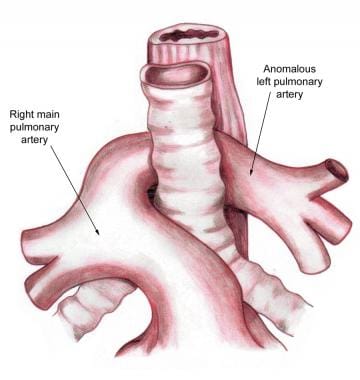Background
Pulmonary artery sling is a rare defect created by anomalous origin of the left pulmonary artery from the posterior aspect of the right pulmonary artery. The anomalous left pulmonary artery courses over the right mainstem bronchus and then from right to left, posterior to the trachea or carina and anterior to the esophagus, to reach the hilum of the left lung. This compresses the lower trachea and right mainstem bronchus, producing upper airway symptoms. Compression caused by the sling can produce obstructive emphysema, atelectasis of the right and left lungs, or both. Thus, early recognition and diagnosis of pulmonary artery sling, and of stridor in a young infant, are crucial.
An example of pulmonary artery sling is shown in the illustration below.
Aberrant left pulmonary artery or pulmonary artery sling.
Associated tracheobronchial abnormalities may occur, especially complete tracheal rings and tracheomalacia. Hypoplasia and stenosis of tracheal segments occur and can potentiate the airway obstruction. Congenital heart defects are found in 50% of pulmonary artery sling cases, most commonly atrial septal defect, patent ductus arteriosus, ventricular septal defect, and left superior vena cava.
Other organ system abnormalities may occur. These include imperforate anus, Hirschsprung disease, biliary atresia, and genitourinary defects. Abnormalities of ovaries, vertebrae, thyroid gland, and pulmonary parenchyma have been reported.
The specific etiology of the pulmonary artery sling is unknown.

